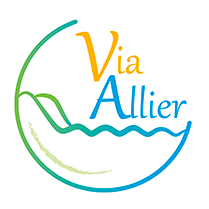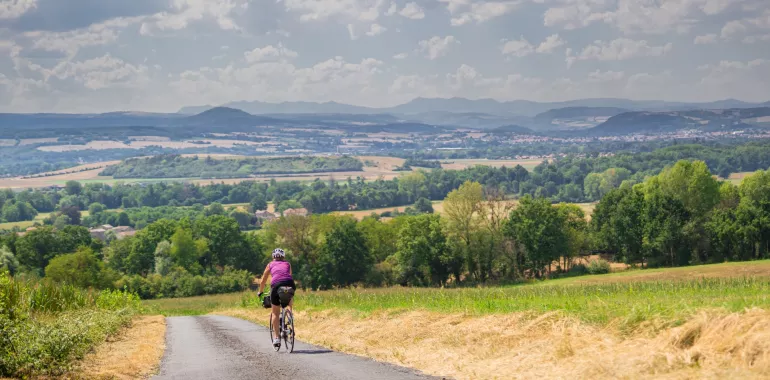13,51 km cycling route from Vic-le-Comte to Issoire
Elevation of the stage
Waytypes of the stage
Surface of the stage
The Via Allier cycle route from Vic-le-Comte to Issoire
The Via Allier cycle route leads you out of Vic-le-Comte via the D49 road in the direction of Saint-Babel, along a hilly road. Cycle up to the Col de la Croix des Gardes, at 654m in altitude. Recover from the effort, enjoying the descent on the other side. Once at the entrance to Saint-Babel, follow signs for Orbeil along the D14 road, continuing the descent to the Allier River. To reach the centre of Issoire, follow the signs, crossing the river via the D9 road (take care), leading you to the railway station and then on to the town centre, riding beside the Couze Pavin River.
Links to Issoire from Orbeil
Coming from the north, at Orbeil, follow the direction of Issoire. To return to the Via Allier cycle route, follow the D996 road via Parentignat and Varennes-sur-Usson.
Don't miss
- Vic-le-Comte: in this historic town awarded Petite Cité de Caractère status, the église Saint-Pierre is a fine Romanesque church given ornate additions in Gothic and Renaissance periods.
- Pignols: the église Sainte-Magdeleine, Romanesque in origin, is a listed church containing a remarkable set of mural paintings going from the 12th to the 16th centuries.
- Pignols et Vic-le-Comte: Production of wines designated AOP Côte d’Auvergne.
- Coudes: the suspension bridge spanning the Allier River, built in 1846, its single section measuring 100m in length and 4.4m in width, is held up by cables. Destroyed by the German Army in World War II, it was rebuilt in 1944. A new, modern bridge was opened parallel to it in 1976 and the suspension bridge is no longer open to motorized vehicles.
- Issoire :
- Abbatiale Saint-Austremoine, the largest Romanesque church in Basse Auvergne (northern Auvergne), considered a masterpiece of Romanesque art, dating back to the late 11th and early 12th centuries.
- Tour de l’Horloge: with a viewing platform offering views of the town and surrounding countryside, plus it holds exhibitions, lectures, workshops and projections.
- Espace Culturel Jean Prouvé: for art exhibitions.
- Auverdrive: for its collection of cars.
- Centre d’Art Contemporain Karoutzos: displaying c.300 contemporary works by regional, national and international artists conveying a wide range of moods in all manner of forms.
- Jardin du Château d’Hauterive: 17th- and 18th-century gardens, including a terraced vegetable garden, hornbeam alleys and copses offering green shady corners, plus a wine cellar, wine-pressing chamber, bread oven and ice house.
- Parentignat suspension bridge: built in 1831, the first in the area to enable people to cross the Allier by road instead of using the little ferries, or bacs, at Parentignat, Orbeil and Les Pradeaux. It has two stone arches, but the suspended section was made of iron, the whole measuring 120m in length, 6m in width. It hasn’t been in use since 1976, replaced by a more modern bridge.
- Château de Parentignat, with English-style grounds: nicknamed the Petit Versailles d’Auvergne by regional writer Henri Pourrat, this château was built towards the end of Louis XIV’s reign and underwent transformations in the late-18th century.
Railway station
Issoire : Line TER Clermont-Ferrand <> Issoire


Travellers’ reviews